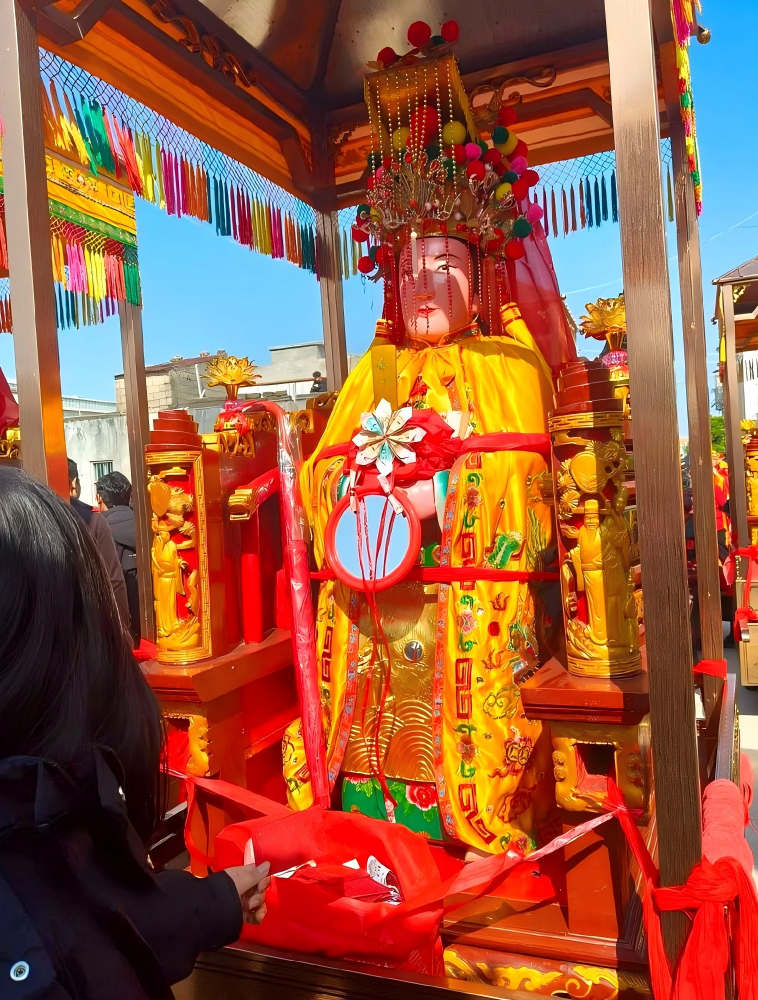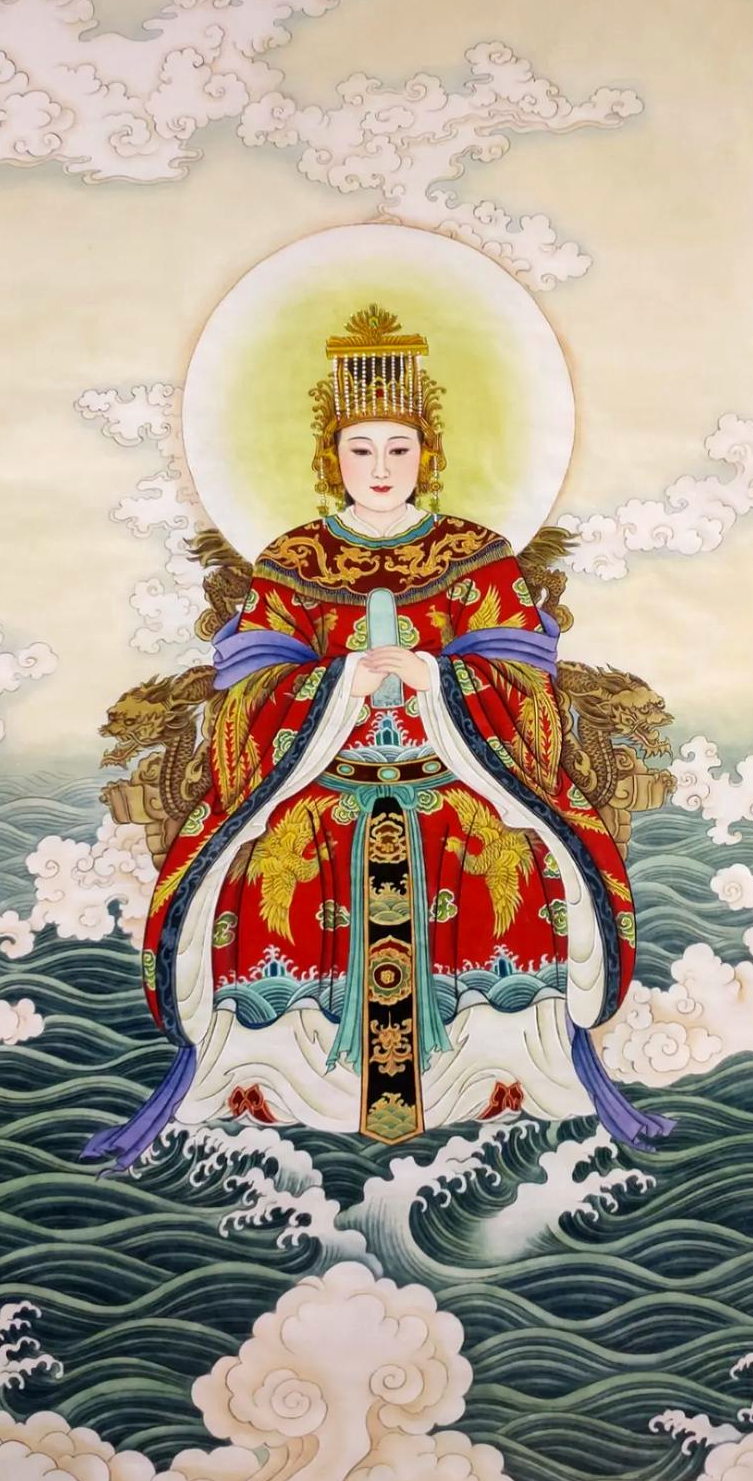Mazu’s surname is Lin. It is said that she was born in Dongluo Village, Meizhou Island, Putian County, Quanzhou, Qingyuan Army in the first year of Jianlong in the Northern Song Dynasty (960).
According to folklore, Mazu “did not cry when she was born”, so she was named “Mo” (meaning silence in Chinese). Some documents may record her as “Mo Niang”, and “Niang” was a common name for women with a single name in the old days, so Mazu’s original name should be “Lin Mo”.
She was a fairy who practiced both Buddhism and Taoism. She could predict good and bad luck for people and remained unmarried all her life. After her ascension, it was rumored that she often appeared in the turbulent sea in the image of “a beautiful woman with long hair and plain face in red clothes”, and could turn typhoons to protect the safety of ships. The worship of her by sailors and fishermen gradually turned into a belief.
The Mazu culture in Teochew and Fujian is of the same origin
Minnan and Teochew share the same blood relationship, the same origin and customs, and have many similarities and even similarities in folk beliefs. In particular, the belief in Mazu, the sea protector, is more prominent.
It can be said that it is the same Mazu, the same ocean sentiment.
Experts point out that the numerous Mazu temples in Teochew are directly related to the historical immigration of Fujian immigrants to Teochew, and are also a concentrated reflection of the folk beliefs of the coastal areas of Teochew.
Mazu belief is a bridge
Nowadays, people’s belief in Mazu has far exceeded the meaning of eliminating disasters and praying for blessings. The feelings of seeking roots and nostalgia for homeland have taken a dominant position.
“Mazu belief is not only a folk custom passed down for thousands of years, a cultural accumulation. It is also a national bloodline, and a bridge to strengthen the connection between compatriots and overseas Chinese at home and abroad and enhance national cohesion.”
History: Fujianese migrated to Teochew, and Mazu also “migrated”
There are many Mazu temples in Teochew, mainly distributed in Shantou, Chenghai, Raoping and other places. The Mazu belief in Teochew is also directly related to the immigration of Fujianese to Teochew.
An expert in the origin of surnames pointed out that after the Song Dynasty, there was an endless influx of Fujian immigrants, and Fujian’s folk beliefs also spread to the places of immigration with the immigrants. The history of the Tianhou temples in Teochew can mostly be traced back to the Song, Yuan and Ming dynasties.
War leads to immigration
At the end of the Song Dynasty, Putian was the most tragic place in the country to resist the Yuan Dynasty. In the Ming Dynasty, Japanese pirates plundered Putian several times, and Putian was massacred twice in the late Song Dynasty and the Ming Dynasty. Many people immigrated to other places, especially Teochew, for refuge.
These immigrants were forced to leave their homes, and they carried incense, Mazu flags, and talismans to find a new home. After settling in Teochew and other places, they advocated building Mazu temples to thank Mazu and express their longing for their homeland.
Since the belief in Mazu includes traditional Chinese virtues such as being kind, helping others, and suppressing evil, it is easy to be accepted and recognized by people, and it quickly spread and developed in Chaoshan and other places.
Mazu has become Zhanglin’s “one of our own”
The folk customs in southern Fujian and Chaoshan are similar, and the belief of the people in the two places in Mazu, the sea protector, is particularly prominent.
According to reports, Zhanglin Ancient Port in Chaoshan was an important port for foreign trade, overseas immigration and cultural exchanges between China and foreign countries in ancient Chaoshan. Since Meizhou, Fujian, welcomed Mazu, it has been thoroughly soaked in the “Teochew flavor”.
“Aunt” of the Lin clan in Zhanglin Port – Mazu
Especially, the Lin clan in Zhanglin Port has become a relative of “her”, and has always said that “she” is “one of our own”, and affectionately calls her “aunt”.
The locals also stipulate that if a family in the clan marries a new daughter-in-law, the bride must bring a plate of oranges and a basin of water to the temple early the next morning to wash the face and make up for the “aunt” and show filial piety to the “aunt”. This folk custom has also spread throughout Chaoshan.
Boatmen worship Mazu
The worship of Mazu has spread from Putian to Chaoshan, and has undergone many changes.
Worship time
In the past, when Chaoshan boatmen launched new boats, they would always go to the “Mazu Temple” on Mayu Island in Shantou Port to ask for incense (explanation) and bring back the incense table of “Holy Queen Mazu” in the boat. In addition to burning incense and gold ingots on the first and fifteenth day of the lunar month, they would also worship Mazu solemnly on Mazu’s birthday.
Even the most stingy boat owners would offer “five animals” or “three animals” to Mazu on this day, and then entertain all the boat staff with a feast. When the boats from upstream approach Chaozhou City, they would burn incense and worship Mazu to bless them to cross Xiangzi Bridge safely. Whenever the boats successfully pass the bridge hole, they would set off firecrackers to Jiang Ming to thank Mazu.
Worship activities for Mazu’s birthday

Every March 23rd, the “Mazu birthday” activities in various places are very grand. On this day, each village selects several groups of young people to be the “bearers” of Mazu’s sedan chair. The “bearers” are all strong and powerful, and most of them are young men who have been married for many years but have no children or have just married.
When “Mazu goes out for a tour”, the statue of the deity is first brought out from the Mazu temple, and after it is placed in the sedan chair, the horse-head gong (explanation) is sounded to clear the way. The order of appearance is:
1 Carry out the big incense burner
2 Then carry out the Mazu sedan chair
3 Then the gods
4 Then the characters in the story (played by real people) and trophies, banners, etc.
The crowds along the streets and alleys are watching, and the housewives of the families must set up incense tables on the roadside for worship. Each household lights long firecrackers to welcome it. When Mazu’s sedan chair passes by, the worshippers take three burning incense sticks and insert them into the burner in front of the team. (Picture)

Interesting customs
If the onlookers have been married for many years but have no children and it is not their turn to carry the sedan chair, they will squeeze to the front to touch the statue or the top of the sedan chair. If they can touch it, it means that they will give birth to a son this year.
When the statue is sent back to the temple after the “Mazu Tour”, it depends on which sedan chair runs faster. The faster one will have a more auspicious new year. Therefore, when approaching the temple, the sedan chair bearers always run as fast as they can.
At this time, the old and weak can hardly catch up with them even if they take off their clogs and hold them in their hands. Therefore, the Chaoshan folk saying goes: “Throwing clogs can’t catch up with the temple” (used to describe poor ability and not being able to keep up with others).
Mazu is a goddess in coastal areas
Mazu is a famous sea god in the world and a deity worshipped by coastal areas including Guangdong. In Guangdong, many Cantonese and Hakka people also believe in Mazu, but since Teochew people often survive in the sea, Mazu worship is particularly prominent among Teochew people.
In the Shanwei area, even children’s names are related to Mazu and Buddha, usually with “Ma”, “Niang” and “Fo” as common names, all in the hope of Mazu’s blessing.
History of the construction of Mazu temples
Guangdong and Fujian have convenient transportation, and there were Mazu temples in Guangdong as early as the Song Dynasty. Teochew Tianfei Temple began in the Song Dynasty. Shantou Fangjishan Tianfei Palace was built in the fourth year of the Wanli period of the Ming Dynasty (1576) and was donated by General Yan Jifang.
Nowadays, many places along the coast of Guangdong still have religious buildings such as “Tianfei Temple” and “Tianhou Palace”, including Nan’ao Mazu, Shantou Mayu, Jiexi Tianhou Palace, Haifeng Tianhou Palace, Shenzhen Chiwan Tianhou Palace, Yangjiang Zuchuang Palace, Diantian Tianhou Palace, Yaliao Tianhou Palace, Hai’an Mazu Palace, and Nanzhou Tianhou Palace… There are too many to count.
There are also many in northern and eastern Guangdong, such as Lianxian and Jiaoling. Some places still retain place names related to Tianfei and Tianhou.


Leave a Reply